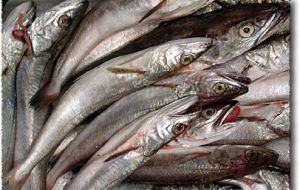MercoPress. South Atlantic News Agency
Alarming signals about South Atlantic hake fishery fragility
 South Atlantic hake
South Atlantic hake A significant drop in the South Atlantic common hake (Merluccius hubbsi) breeding biomass and other alarming signals were collected in the latest report from Argentina's National Institute for Fisheries Research and Development, INIDEP, particularly in an area north of parallel 41 S.
"The results of the latest research cruises show a marked trend towards the decline of the breeding biomass between 1986 and 2006" said experts involved in the drafting of INIDEPs Technical Report Nº 93/06, Gabriela Irusta and Marta Renzi. Because of high mortality rates, caused by the catches of juveniles and adults, the short term (3 years) recovery of the hake fishery is not expected to reach 130.000 tons but, "rather less than 80.000 tons". "With variable recruitment and the possibility that the population encounters excess of recruitment over fishing, it has been suggested to consider catching options in the short term" points out the report. INIDEP scientists from the Hake Project suggest that catches for the 2007 season north of parallel 41 S, should not exceed 50.000 tons including shares from Argentina, Uruguay and Brazil. Argentina's Agriculture, Livestock, Fisheries and Food Ministry show that common hake catches north of parallel 41 S reached 27.541 tons, way below the 75.600 tons TAC for the area, which reflects the extremely delicate situation of the fishery. However a final draft will not be presented until the conclusion of data analysis from the current cruise research that begun a couple of weeks ago. The Evaluation Campaign of Argentine Hake Juvenile Abundance in the North Patagonian Breeding Area started January 10 when the oceanographic vessel "Eduardo Holmberg" left Mar del Plata. The campaign will last 28 days and is mainly aimed to determine the concentration area of the common hake juveniles and to record abundance indexes in that area according to the age of every juvenile group of the species. However these preliminary results have contributed to scientists growing concern over the situation of the common hake fishery, --which is one of Argentina's main export items--, revealing the biological fragility of the southern stock. Scientists believe that the decline in recruitment south of parallel 41º S will have negative effects for fishing activities well into 2008 and later. One of the proposals to improve the hake resource recovery in the north-Patagonian zone, according to the INIDEP experts, would be to safeguard juveniles and protect the main spawning area, between parallels 35º S and 37º S, during the autumn and winter months. (FIS/MP).




Top Comments
Disclaimer & comment rulesCommenting for this story is now closed.
If you have a Facebook account, become a fan and comment on our Facebook Page!